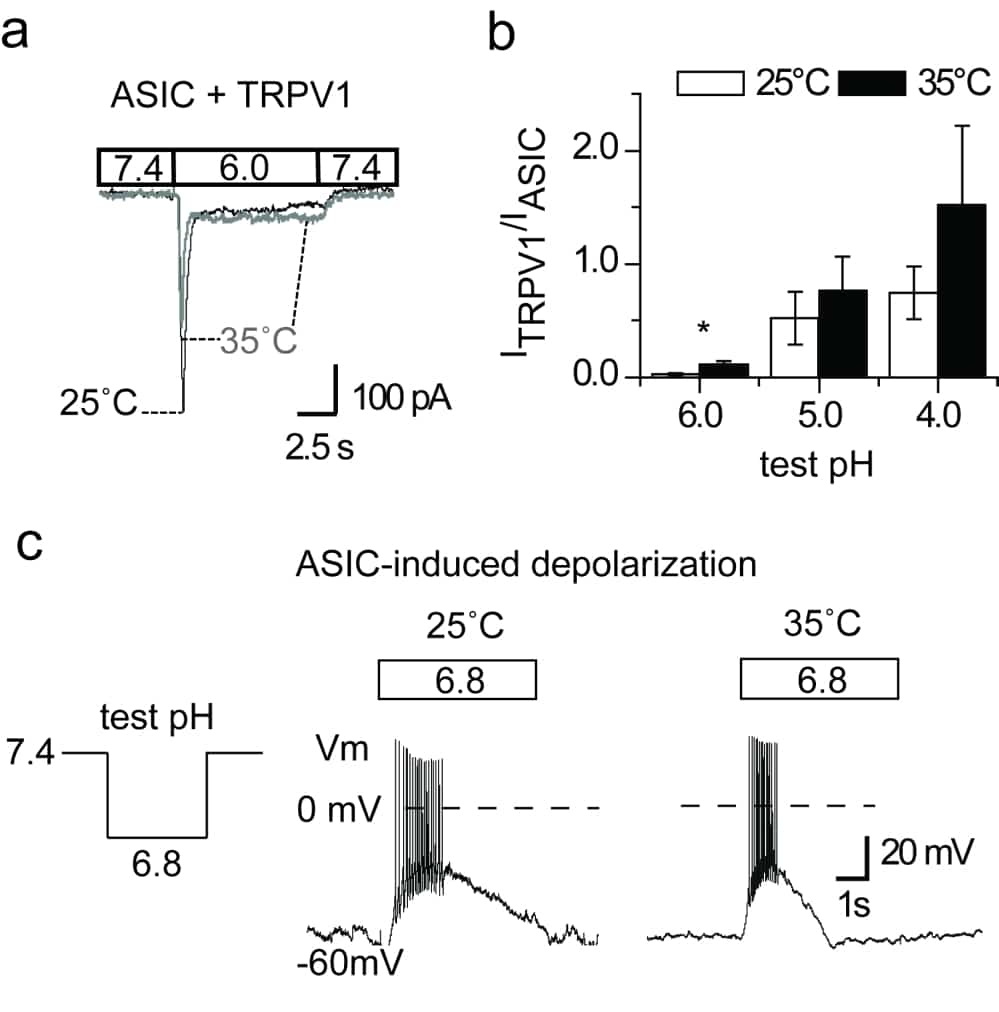Acid-sensing ion channels (ASICs) are neuronal H+-gated cation channels, and the transient receptor potential vanilloid 1 channel (TRPV1) is a multimodal cation channel activated by low pH, noxious heat, capsaicin, and voltage. ASICs and TRPV1 are both expressed in sensory neurons (1). It has been shown that raising the temperature increases TRPV1 and decreases ASIC H+-gated current amplitudes (2). To understand the underlying mechanisms, we have analyzed ASIC and TRPV1 function in a recombinant expression system and in rat dorsal root ganglion (DRG) neurons at room and physiological temperature (25 and 35°C). We show that in this range, the temperature does not affect the pH dependence of ASIC and TRPV1 activation. A temperature increase induces, however, a small alkaline shift of the pH dependence of steady-state inactivation of ASIC1a, ASIC1b, and ASIC2a. The decrease in ASIC peak current amplitudes at higher temperatures is likely in part due to the observed accelerated open channel inactivation kinetics and for some ASIC types to the changed pH dependence of steady-state inactivation. The increase in H+-activated TRPV1 current at the higher temperature is at least in part due to a hyperpolarizing shift in its voltage dependence. ASIC and TRPV1 currents of DRG neurons are similarly regulated by temperature as the cloned channels, with the exception that the decrease in peak ASIC current amplitudes at 35°C is more pronounced in DRG neurons. The low pH-evoked depolarization measured under current-clamp was significantly reduced at 35°C for a sub-population of ASIC channels, without however affecting the number of action potentials. Our study shows that the contribution of TRPV1 relative to ASICs to H+-gated currents in DRG neurons increases with higher temperature and acidity. Still, ASICs remain the principal pH sensors of DRG neurons at 35°C in the pH range ≥6.
Durham University (2010) Proc Physiol Soc 21, C03 and PC03
Oral Communications: Effect of a temperature increase in the non-noxious range on proton-evoked ASIC and TRPV1 activity
M. G. Blanchard1, S. Kellenberger1
1. Pharmacology and Toxicology, University of Lausanne, Lausanne, Switzerland.
View other abstracts by:
Patch clamp experiments were performed in rat DRG neurons expressing ASIC and TRPV1 channels. a) ASIC and TRPV1 are differentially modulated by temperature. Increasing the temperature from 25 to 35°C reduced ASIC pH 6-evoked current while increasing TRPV1 activity. b) ASIC currents were larger than TRPV1 at both 25 and 35°C at pH>=6. c) Higher temperature increased the frequency of low pH-evoked action potentials but did not affect the number of spikes.
Where applicable, experiments conform with Society ethical requirements.

